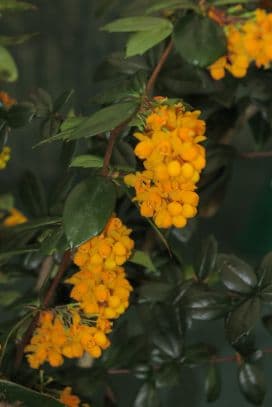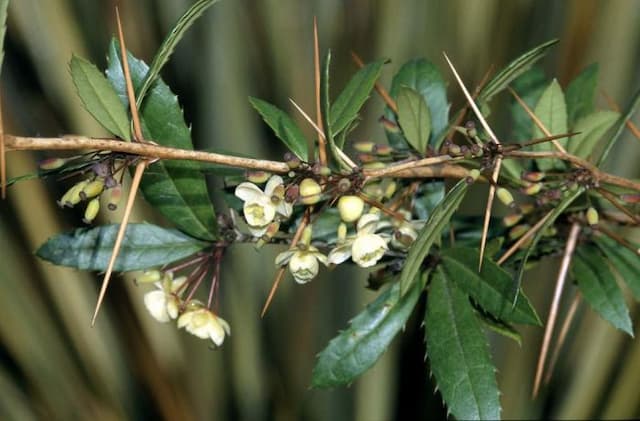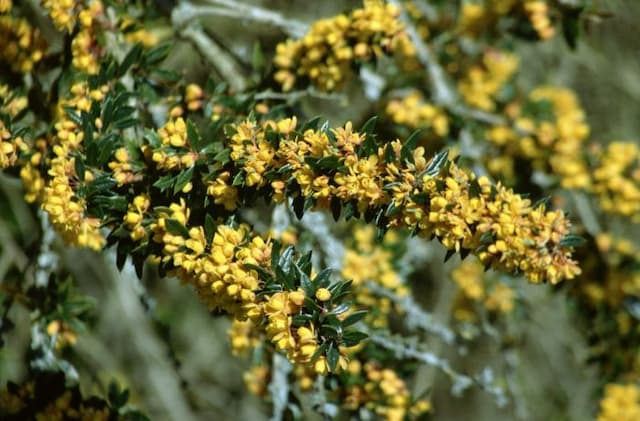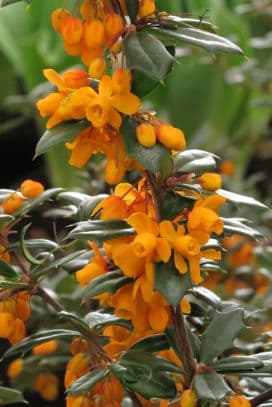Yellow Epimedium Epimedium flavum

ABOUT
Epimedium flavum, commonly known as yellow epimedium, is a decorative plant known for its distinctive foliage and flowers. Its leaves emerge with a reddish tinge in spring, maturing to a fresh green as the season progresses. The foliage maintains interest throughout the growing season, often turning to attractive shades of bronze, red, or purple in the fall, providing a striking contrast to the flowering elements and the landscape around it. The most striking feature of yellow epimedium is its flowers. The plant boasts an array of delicate, yellow flowers that seem to float above the foliage on wiry, slender stems. Each flower possesses a unique, intricate structure, notable for its spurs that extend backward, giving them a whimsical, fairy-like appearance – a characteristic that has earned them the nickname "fairy wings." The blooms typically appear in mid to late spring, creating a soft yet bright splash of color that is particularly eye-catching. Although this response does not detail the size of yellow epimedium, the plant's structural qualities contribute significantly to its ornamental value, making it a popular choice for gardeners looking to add texture and long-lasting visual interest to their shaded garden areas. Its relatively low-maintenance and resilient nature further enhances its appeal, allowing the plant to thrive and bring beauty to the landscape year after year.
About this plant
 Names
NamesFamily
Berberidaceae
Synonyms
Yellow Epimedium, Yellow Horned Goat Weed, Yellow Barrenwort
Common names
Epimedium flavum
 Toxicity
ToxicityTo humans
Epimedium flavum, commonly known as yellow barrenwort, is not typically considered toxic to humans. There is no widespread documentation or reports of significant toxicity in humans from consuming or handling yellow barrenwort. As with any plant, individual allergic reactions or sensitivities are always possible, and it is generally recommended to exercise caution when handling or ingesting plants that are not commonly used as food. If an individual has specific health concerns or plant allergies, consulting a healthcare professional is advisable.
To pets
The plant Epimedium flavum, commonly referred to as yellow barrenwort, is not known for being toxic to pets. There are no significant reports of poisoning or serious health issues associated with pets ingesting yellow barrenwort. However, as with all non-food plants, it is generally advised to prevent pets from eating large quantities to avoid potential stomach upset or an unexpected allergic reaction. If a pet does consume yellow barrenwort and exhibits unusual symptoms, it is best to contact a veterinarian.
 Characteristics
CharacteristicsLife cycle
Perennials
Foliage type
Deciduous
Color of leaves
Green
Flower color
Yellow
Height
1-1.5 feet (30-45 cm)
Spread
1-2 feet (30-60 cm)
Plant type
Herb
Hardiness zones
5
Native area
China
Benefits
 General Benefits
General Benefits- Attracts Pollinators: Epimedium flavum flowers are known to attract bees and butterflies, which are essential for pollination in the garden.
- Drought Tolerance: Once established, Epimedium flavum can tolerate periods of dryness, making it suitable for xeriscaping and low-water garden designs.
- Ground Cover: It can serve as an effective ground cover, spreading to fill space and suppress weeds with its dense foliage.
- Shade Tolerant: It is well-suited for growing in shaded areas where other plants might struggle, providing greenery and flowers under tree canopies and in shadowed garden corners.
- Deer Resistant: Epimedium flavum is not a preferred plant for deer, making it a good choice for gardens in areas with high deer populations.
- Low Maintenance: The plant requires minimal care once established, making it a good option for gardeners looking for plants that do not need constant attention.
- Ornamental Foliage: The leaves of Epimedium flavum can provide visual interest with their shape and sometimes with seasonal color changes in fall.
- Border Planting: Epimedium flavum's compact growth habit makes it an excellent choice for use in borders and edges of garden paths or flower beds.
 Medical Properties
Medical Properties- Libido Enhancement: Epimedium flavum, commonly known as Barrenwort, has been traditionally used to increase sexual desire.
- Erectile Dysfunction: Some compounds in Barrenwort are thought to have effects that might help with erectile dysfunction.
- Osteoporosis Prevention: Barrenwort contains icariin, which has been suggested to be beneficial in maintaining bone health and preventing osteoporosis.
- Anti-inflammatory Properties: The plant has been used in traditional medicine for its potential anti-inflammatory effects.
- Immunomodulatory Effects: There is some evidence to suggest that Barrenwort might influence the immune system.
- Antioxidant Effects: Barrenwort is believed to have antioxidant properties, helping to protect cells from damage.
 Air-purifying Qualities
Air-purifying QualitiesThis plant is not specifically known for air purifying qualities.
 Other Uses
Other Uses- Ground Cover: Epimedium, also known as Barrenwort, can be used as a ground cover plant due to its spreading habit and attractive foliage, providing a low-maintenance solution for filling in bare spots in the garden.
- Erosion Control: Due to its dense growth, Barrenwort is effective at stabilizing soil and preventing erosion on slopes and in areas prone to soil loss.
- Border Planting: With its delicate flowers and leaf shapes, Barrenwort is ideal for border planting, offering a soft edge to garden paths and walkways.
- Fairy Gardens: Due to its whimsical appearance, Barrenwort is often used in creating fairy gardens, adding a touch of enchantment to these miniature landscapes.
- Shade Garden Accent: Barrenwort thrives in shady areas, and its attractive leaves and flowers can provide visual interest in gardens that do not receive a lot of sunlight.
- Winter Interest: Some varieties of Barrenwort have evergreen foliage that can add color and texture to otherwise barren winter gardens.
- Companion Planting: Barrenwort can be paired with other shade-loving perennials such as hostas and ferns to create a lush, layered garden design.
- Potted Plant: It can be grown in containers on shaded patios or balconies, where its ornamental qualities can be enjoyed up close.
- Dried Arrangements: The unique leaves of Barrenwort can be dried and used in floral arrangements and crafts where a touch of greenery is desired.
- Underplanting for Trees: Barrenwort is ideal for underplanting beneath deciduous trees and shrubs, as it can handle the changing light conditions throughout the seasons.
Interesting Facts
 Feng Shui
Feng ShuiThe plant Epimedium, commonly known as Horny Goat Weed, is not used in Feng Shui practice.
 Zodiac Sign Compitability
Zodiac Sign CompitabilityHorny Goat Weed is not used in astrology practice.
 Plant Symbolism
Plant Symbolism- Enduring Love: Epimedium, commonly known as "Horny Goat Weed," is often associated with love and long-lasting relationships due to its reputation as an aphrodisiac.
- Sexual Vitality: The plant's aphrodisiac properties have led to symbolism surrounding sexual health and vitality.
 Water
WaterBarrenwort requires consistent moisture, especially during dry seasons, but it's important not to overwater. The soil should be kept lightly moist. During the growing season, watering once a week with about one gallon of water should suffice. During hotter periods, you may need to water more frequently, ensuring that the water penetrates the soil to a depth of at least one inch. During the winter months, watering can be reduced as the plant goes dormant, requiring only enough water to prevent the soil from completely drying out.
 Light
LightBarrenwort thrives best in partial to full shade, so positioning it in a spot where it receives dappled sunlight under trees or beside taller shrubs would be ideal. It can tolerate some morning sun but should be sheltered from the intense afternoon sun which can scorch its delicate leaves. The best spot is one where it receives indirect light most of the day.
 Temperature
TemperatureBarrenwort is hardy and can tolerate a range of temperatures. It can survive in temperatures as low as -30 degrees Fahrenheit and as high as 85 degrees Fahrenheit. The ideal temperature range for growing Barrenwort would be between 50 and 70 degrees Fahrenheit, which helps to promote healthy growth and flowering.
 Pruning
PruningPrune Barrenwort in late winter or early spring before new growth begins, to remove old, damaged, or dead foliage, and to maintain plant health and appearance. This encourages new, vibrant growth and improves airflow, which can help prevent disease. Generally, once-annual pruning is sufficient, and the best time is when plants are still dormant.
 Cleaning
CleaningAs needed
 Soil
SoilBarrenwort prefers moist, well-drained soil rich in organic matter with a pH of 6 to 7. The best soil mix can be created by blending equal parts of garden loam, peat moss or compost, and sharp sand or perlite.
 Repotting
RepottingBarrenwort does not require frequent repotting; it should be repotted every 3 to 4 years to refresh the soil and divide the roots if necessary.
 Humidity & Misting
Humidity & MistingBarrenwort thrives in average to slightly higher indoor humidity levels but is adaptable and does not require special humidity considerations.
 Suitable locations
Suitable locationsIndoor
Place Barrenwort in bright, indirect light and ensure good air circulation.
Outdoor
Plant Barrenwort in partial to full shade, protect from strong winds.
Hardiness zone
5-9 USDA
 Life cycle
Life cycleEpimedium flavum, commonly known as Yellow Epimedium, begins its life cycle with seed germination, which typically occurs in spring. The seeds develop into small rosettes of heart-shaped leaves that remain close to the ground. As the plant matures, it establishes a robust rhizome system from which new growth emerges each year. Flowering occurs from early to late spring, featuring dainty yellow flowers held above the foliage on slender stems. After pollination, usually by insects, the flowers develop into small, dry, and dehiscent fruits that release seeds for propagation. Yellow Epimedium is a perennial plant, and after the growing season, the foliage often remains evergreen or semi-evergreen, depending on the climate, until the cycle begins anew with the next seasonal growth spurt.
 Propogation
PropogationPropogation time
Spring to Summer
The most popular method of propagation for Epimedium flavum, commonly known as Yellow Epimedium, is through division. This process is best done in the fall or early spring when the plant is not in active growth. To propagate by division, carefully dig up the entire plant, making sure to keep a good amount of soil around the roots to reduce shock. Gently tease apart the clumps into smaller sections, each with several growth points and a healthy root system. Replant the divisions immediately into well-drained soil, spacing them about 12 inches (approximately 30 centimeters) apart. Water the newly planted divisions thoroughly to help establish them in their new location. Division not only helps in propagating new plants but also invigorates older clumps that might have become woody or less vigorous.







![Japanese barberry [Bonanza Gold]](/_next/image?url=https%3A%2F%2Fplants-admin.emdemapps.com%2Fimages%2Fplants%2F%2Fimages%2F604b5385e413f.png&w=640&q=75)

